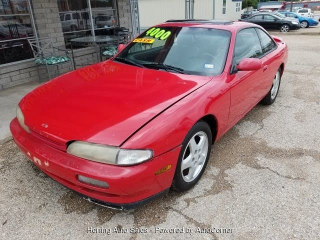The Good
The 1995 240SX offers superb handling and a lightweight, rear-wheel-drive platform, appealing strongly to emotional buyers seeking driving purity. Its simple, durable KA24DE engine provides practical reliability and decent efficiency for its class. The timeless coupe design and strong aftermarket support add to its lasting value, making it a desirable classic sports car for both enthusiasts and daily drivers.
The Bad
Potential weaknesses for the 1995 Nissan 240SX include a somewhat underpowered stock engine (KA24DE) for serious performance aspirations, leading many to perform engine swaps. Common issues involve timing chain guide wear, oil leaks (especially valve cover and oil pan), and aging suspension components. Rust can also be a significant concern in salt-prone regions, particularly around wheel arches and subframes.
1995 Nissan 240SX: Quick Overview
- Engine Options: The 1995 Nissan 240SX for the North American market was exclusively equipped with one engine option: the naturally aspirated 2.4-liter KA24DE inline-four cylinder engine. Unlike its Japanese counterparts that received SR20DET turbo engines, the KA24DE was the standard and only offering.
- Horsepower: This 2.4L KA24DE engine produced 155 horsepower at 5,600 rpm and 160 lb-ft of torque at 4,400 rpm. This power output was considered adequate for daily driving and spirited cruising, though it often left enthusiasts wanting more for serious performance applications.
- Fuel Economy: Fuel economy figures for the 1995 240SX were respectable for a sports coupe of its era. Owners could expect approximately 21-22 MPG in the city and 26-28 MPG on the highway with the manual transmission. Automatic transmission models typically saw slightly lower figures.
- 0-60 Times: The 0-60 mph acceleration times for the 1995 Nissan 240SX generally ranged from 7.5 to 8.5 seconds, depending on the transmission (manual usually being quicker) and driver skill. While not blisteringly fast, it offered sufficient acceleration for enjoyable driving.
- Towing Capacity: The Nissan 240SX was not designed for towing, and Nissan did not provide an official towing capacity. It is strongly advised against using this vehicle for any towing purposes due to its sports-oriented chassis and powertrain limitations.
- Trim-Level Features:
- Base Model: The entry-level trim typically included power windows, power locks, power mirrors, a four-speaker AM/FM cassette stereo, and a basic cloth interior. Air conditioning and anti-lock brakes (ABS) were often optional.
- SE Model: The SE trim was the more premium offering, building upon the Base model's features. It often included 16-inch alloy wheels (vs. 15-inch steel wheels or alloys on the Base), a viscous limited-slip differential (VLSD) for enhanced traction, a sport-tuned suspension, four-wheel disc brakes (ABS became standard or widely available), a power moonroof, a rear spoiler, and a leather-wrapped steering wheel. Optional features on the SE could include a CD player and leather seating surfaces.
1995 Nissan 240SX Specifications
Vehicle Information
| Year | 1995 |
| Make | Nissan |
| Model | 240SX |
| Trim | - |
| Style | Coupe 5-Speed Manual |
| Type | Coupe |
| Category | Minicompact Car |
Manufacturing Details
| Made In | Japan |
| Manufacturing City | MIYAWAKA |
Dimensions
| Doors | 2-Door |
| Curb Weight | 2816 pounds |
| Gross Vehicle Weight Rating | - |
| Overall Height | 51.00 inches |
| Overall Length | 177.20 inches |
| Overall Width | 68.10 inches |
| Wheelbase Length | 99.40 inches |
| Standard Seating | 4 |
Engine & Performance
| Engine | 2.4-L L-4 DOHC 24V |
| Engine Size | 2.4L |
| Engine Cylinders | 4 |
| Transmission | 5-Speed Manual |
| Transmission Type | Manual |
| Transmission Speeds | 5-Speed |
| Drivetrain | Rear-Wheel Drive |
Additional Features
| Anti-Brake System | Non-ABS 4-Wheel ABS |
| Steering Type | Rack & Pinion |
Pricing
| Manufacturer Suggested Retail Price (MSRP) | $18,099 |
| Invoice Price | - |
| Delivery Charges | - |
Vehicle History Report
Specifications
History
Events
History Check
Check
Check
Check
Check
Listings
Recalls
Check
Analysis
What Problems Does the 1995 Nissan 240SX Have?
Another common problem involves the clutch hydraulic system, specifically the clutch master and slave cylinders. Leaks or failures in these components can result in a soft clutch pedal or complete loss of clutch engagement, requiring replacement. Suspension components, such as control arm bushings, tie rod ends, and ball joints, are also prone to wear after decades of use, leading to loose steering, clunking noises, and compromised handling. Replacement with aftermarket or OEM parts is a common maintenance item for enthusiasts seeking to restore the car's famed handling.
Rust is a significant concern, especially in regions with harsh winters or coastal environments. Common areas for rust include the rocker panels, wheel arches, subframes, and even the strut towers. Thorough inspection for rust is critical when purchasing a used 240SX. Electrical issues, such as failing window motors, dashboard lights, or intermittent sensor failures, can also arise due to aging wiring harnesses and components.
As for recalls specific to the 1995 model year, comprehensive lists are sometimes hard to track for older vehicles, but general safety recalls related to airbags (like the widespread Takata airbag recall) or minor electrical components might apply across several Nissan models of that era. Prospective owners should always check the VIN for any outstanding recalls. Overall, the S14 240SX benefits from a strong aftermarket and readily available parts, making most of these issues addressable with proper maintenance and repair.
How long will the 1995 Nissan 240SX last?
Long-term durability is high for the core mechanicals, but weaknesses emerge in ancillary components over time. Suspension bushings and ball joints will inevitably wear, requiring replacement to maintain handling. Electrical gremlins, especially related to windows and dashboard components, become more frequent. Rust, particularly in untreated areas or accident-repaired sections, can significantly degrade the chassis and body integrity. Despite these age-related issues, the 240SX's robust platform and strong aftermarket support ensure that most components can be repaired or upgraded, allowing these cars to remain on the road for decades with dedicated ownership.
What Technology & Safety Features are Included?
Built-in Tech & Entertainment:
Standard tech was basic, focusing on functionality. Owners typically received a four-speaker AM/FM cassette stereo system. Higher trims or optional packages might have included a CD player. Air conditioning and power windows, locks, and mirrors were common features, though some base models might have had manual windows. Cruise control was often an option, adding convenience for highway driving. Climate control was manual, operated via dials and sliders, offering heating, ventilation, and air conditioning (if equipped). There were no advanced infotainment screens, Bluetooth connectivity, or USB ports, as these technologies were not mainstream at the time.
Driver-Assistance Features:
Driver-assistance features were virtually non-existent by today's standards. There was no traction control, stability control, blind-spot monitoring, or adaptive cruise control. The driving experience was unassisted, relying entirely on driver input and skill.
Safety Features:
Safety features were in line with federal mandates and common practices of the era. The 1995 240SX came standard with dual front airbags for both the driver and passenger, fulfilling the then-new requirements. Four-wheel anti-lock brakes (ABS) were available as an option on the Base model and often standard on the SE trim, providing improved stopping power and control in emergency braking situations. Three-point seatbelts were standard for front occupants and outboard rear passengers. Side-impact protection was incorporated into the door design, and the chassis was engineered with crumple zones to absorb impact energy.
Crash-Test Ratings:
Specific, detailed crash-test ratings from organizations like NHTSA or IIHS (which were still evolving in their methodologies) are not as readily available or comparable for vehicles of this vintage as they are for modern cars. However, the vehicle met all federal safety standards of its time. It generally performed acceptably in basic frontal impact tests but would not compare favorably to the advanced safety structures and extensive airbag systems found in contemporary vehicles.
What Colors Options are Available?
1995 Nissan 240SX Prices and Market Value
However, in recent years, the depreciation curve has reversed. Current used market prices for a 1995 240SX vary wildly based on condition, mileage, and originality. Clean, unmolested examples with lower mileage can command anywhere from $15,000 to $30,000 or more, especially if they are rare unmolested "time capsule" cars. Heavily modified or neglected examples might still be found for under $10,000, but they often require substantial investment. Factors affecting resale value include the car's original paint, rust-free chassis, working interior components, and a stock (or professionally engine-swapped) powertrain. Its cult status as a drift and tuner platform has significantly boosted its desirability and, consequently, its value.
1995 Nissan 240SX Cost of Ownership
1995 Nissan 240SX Fuel Efficiency
1995 Nissan 240SX Safety Rating
NHTSA
IIHS
1995 Nissan 240SX Warranty
Basic
Powertrain
Rust
1995 Nissan 240SX Insurance
reasonable repair costs.
How Does the 1995 Nissan 240SX Compare to Other Coupe?
Performance: Against FWD rivals like the Honda Prelude, the 240SX's rear-wheel-drive layout offered superior balance and handling dynamics, making it preferred for enthusiasts seeking a pure driving experience, especially in motorsports like drifting. However, the Prelude's VTEC engines (like the H22A) often offered more horsepower (e.g., 190-200 hp in later H22 variants) and quicker straight-line acceleration than the 240SX's 155 hp KA24DE. The Toyota MR2 (SW20) offered mid-engine balance and, in turbo form, significantly more power (e.g., 200-240 hp), making it a faster and more exotic performer, though often pricier and with a trickier handling limit. The Mazda Miata (NA/NB) offered similar RWD purity but with less power and a convertible-only body style, focusing more on lightweight agility.
Features: Feature sets were generally comparable across these vehicles, with power accessories, air conditioning, and basic stereos being common. The 240SX SE trim was well-equipped, matching or exceeding many competitors. However, no competitor truly stood out for groundbreaking tech in this segment during the mid-'90s.
Reliability: All mentioned Japanese rivals shared a reputation for strong reliability. The 240SX's KA24DE engine is renowned for its durability, on par with Honda's B-series and H-series engines and Toyota's 3S-GE/GTE engines. Long-term reliability concerns typically revolve around age-related wear rather than fundamental design flaws for most Japanese competitors.
Price: New, the 240SX was competitively priced, often slotting below turbo MR2s and sometimes similar to Preludes. Used prices have diverged significantly. While the 240SX has seen a massive surge due to its tuner culture status, the Miata has also appreciated. Preludes and non-turbo MR2s generally haven't seen the same dramatic increase in value.
Alternatives:
- For Pure RWD Driving: Mazda MX-5 Miata (NA/NB) offers a similar purist experience with less power but immense fun. The Toyota MR2 (SW20) provides a different mid-engine RWD dynamic.
- For More Power (FWD): Honda Prelude (4th/5th gen) offers a more potent stock engine and impressive FWD handling.
- For European Flair: BMW 3-Series (E36) coupes offer RWD, more luxurious interiors, and a wider range of engines, though maintenance can be higher.
The 240SX remains a compelling choice for its robust aftermarket, RWD chassis, and strong community support, especially for those looking to build a track car or drift machine. Its "underpowered" stock engine is often seen as an invitation for engine swaps.
Final Verdict: Is the 1995 Nissan 240SX a Good Coupe?
Is it worth buying? Absolutely, if you understand what you're getting into. As a used vehicle, its value is on the rise, making it a potential investment. For performance or modification projects, an SE trim is often preferred due to its standard limited-slip differential. If you find a clean, unmolested example, it's a gem. For those wanting a project car, even a rougher shell can be worth it due to its strong platform. However, be prepared for age-related repairs and potential rust. It's a car for the passionate driver who sees its potential beyond its factory specifications.

